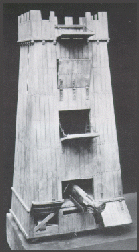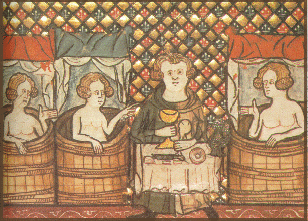
 At the time of Chr�tien de Troyes, the rooms where the lord of a castle, his
family and his knights lived and ate and slept were in the Keep (called the
Donjon), the rectangular tower inside the walls of a castle. This was meant
to be the strongest and safest place.
At the time of Chr�tien de Troyes, the rooms where the lord of a castle, his
family and his knights lived and ate and slept were in the Keep (called the
Donjon), the rectangular tower inside the walls of a castle. This was meant
to be the strongest and safest place.
<< Falaise Castle in Normandy in France
This is the rectangular keep at Falaise Castle in Normandy in France (the round tower was added several hundred years afterwards). Later on, round keeps began to be built because rectangular ones could be attacked at the corners, which were their weakest parts.
Before we look at the rooms inside, let's see how the different parts of a castle fit together.

labelled diagram of layout of a medieval castle

These are the walls at Falaise Castle (above). The castle was built by the Duke of Normandy in the 11th Century. William the Conqueror was born here in 1027. Another example of the Norman style of building is The White Tower of The Tower of London

Tower of London
Like most castles, Falaise stands on a hill so any enemies would have to attack it uphill and the people in the castle would see them coming long before they arrived.
The castle walls are very thick. Some castles had walls five or six metres thick. The round bits you can see sticking out are called bastions. Archers defending the castle could fire arrows from these at people attacking the walls. Arrows could also be fired through narrow slits in the walls called 'murder holes'. The battlements of castles were often made like this

so the defenders could dodge behind them while firing at the attacking army.
The attackers might use huge catapults or battering rams or a kind of giant crossbow called an arbalest. They climbed scaling ladders (special ladders they could throw up and hook on to the walls), holding their shields over their heads while the defenders dropped rocks or poured boiling oil on them. A mixture of boiling oatmeal, like a kind of deadly porridge which stuck to the attacking soldiers, was also used.

Soldiers defending a castle.
Most castles had a ditch or water-filled moat around the walls to make it harder for attackers to get across. Sometimes attackers would dig tunnels under the moat and the walls so that part of the walls would collapse into the water.
Another way of getting into a castle was by using a 'siege-tower'

Siege tower
- a tall wooden tower on wheels which could be moved close to the walls. Attackers in the top of the tower would cross over to the walls of the castle using their own wooden bridge.
Sometimes the attacking army simply surrounded the castle and waited for those inside to run out of food and surrender - but since all castles kept a supply of food ready, these sieges often lasted for as long as two years.
The outer wall of a castle was called the Bailey. Inside the Bailey were buildings where the lord of the castle's cattle, horses and servants lived. Some of the soldiers needed to defend the castle might live in part of the gatehouse (known as the Barbican).

Barbican at Harlech Castle in Wales
This is a picture of the Barbican at Harlech Castle in Wales. If you came to a castle as a friend and not an enemy, you would be allowed to cross the moat by a drawbridge and arrive at the Barbican. If the Porter there let you pass, you would leave your weapons and be taken into the castle itself.
If a castle was attacked, however, the defenders would raise the drawbridge and lower the portcullis (below).

They might also remove parts of the stairs inside the castle, leaving a long drop for any attackers who did manage to get in.
In medieval castles, much of life for the lord and his followers went on in the Donjon. Our word 'dungeon' comes from donjon, because the place for keeping prisoners was also here - though down in the darkest, dampest parts underneath. There were also rooms for storing food. These rooms had to be kept stocked with food to last for a long time in case there was a siege. There was usually a well, so people in the castle could get fresh water. There were kitchens for cooking the daily meals, and pantries where food was stored for everyday use. The Great Hall and the bedchambers were there too. The Donjon might be as much as 70 metres high, with a watchtower where sentries kept watch for any attack and the lord's flag flew from the top.
What were these rooms like?
The most important room in a castle was the Great Hall. This is where all the members of the household sat down to eat at tables set up for every meal. It was where feasts were held for special days, or when there were guests. King Arthur's Pentecost Feast takes place in such a Hall.

The lord carried on nearly all the business of the castle in this Hall, giving orders about the running of his estate, listening to reports from his bailiff or his reeve (the men who managed affairs on his land for him), hearing complaints from one peasant about another.

The Great Hall of Hedingham Castle in Essex
A fire was lit in the middle of the Hall. Smoke found its way out of a hole in the roof. Even with a fire, the big stone room would have been very cold in winter, and people dressed in wool and furs to keep warm. The floor was often covered with rushes and straw (which was changed when it got very dirty). There was not much light, as windows had to be small and high in case of attack, and they had oiled cloth or parchment in them rather than glass. Most people in the Middle Ages went to bed when it got dark and got up when it grew light in the morning. Candles were too expensive (especially beeswax ones) even for the lords of many castles. They used tallow candles (made from the fat of sheep or goats), flaming torches or lamps which burnt fish-oil to light their Great Halls.
For decoration, the beams of the Hall were often painted with patterns. Signs of the zodiac were a favourite design. Tapestries hung on the walls (these made it a bit warmer too). There were wooden tables and benches, with cushions or embroidered cloths. There were also big carved wooden chests with complicated locks holding important documents or linen or precious objects to keep them from thieves and from mice.
 The Bedchamber
The Bedchamber Mice were a problem for clothes too, and in the bedchamber was a pole for hanging clothes on at night so the mice wouldn't nibble them. People didn't wear anything in bed except perhaps a nightcap (nightshirts were not worn until the 14th Century) and they slept half sitting up like this (right)
 Food was roasted or boiled in cauldrons over a fire on a hearth made out of
large blocks of stone. The washing up was done in a tub on the stone floor
nearby.
Food was roasted or boiled in cauldrons over a fire on a hearth made out of
large blocks of stone. The washing up was done in a tub on the stone floor
nearby.
A cooking pan made of bronze (called a skillet - right) which was found by archaeologists at a castle in Norfolk.
A wealthy knight, his family and guests, ate well. Unlike most people, they had plenty of meat: venison (deer), goose, rabbit and hare. On Fridays and Holy Days, when meat was forbidden by the church, they ate fish or eels. If there was to be a special feast, the people working in the kitchens would be kept busy preparing wild boar, or roast swan, or even roast peacock, served with all its feathers as decoration. Other birds enjoyed in the Middle Ages were doves, larks, thrushes and blue-tits. Some of these would be caught by the lord of the castle and his friends while out hunting with their hawks.
Where did people go to the toilet when they lived in a castle? Many castles had stone toilets built over holes in the outer walls. These emptied into a pit far below. The Teutonic Knights (warrior-monks of central Europe) living in the castle of Malbork in Poland used to murder their enemies by inviting them to be guests at the castle and then hurling them down the toilet.

Malbork Castle.
Medieval castles did not have bathrooms with running water, yet people did like to bathe. In some castles there was a room next to the kitchen where women bathed in groups.

People bathing in a public bath-house
The lord might have hot water brought to his bedchamber and poured into a wooden tub. He would sit in it on a low stool. The water might have perfume or rose leaves sprinkled in it. Soap was made of sheep fat with ashes and soda mixed in. Teeth could be cleaned by scraping them with a hazel twig and rubbing them with a woollen cloth.